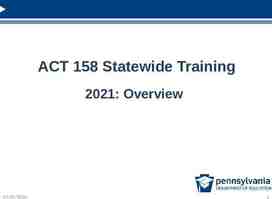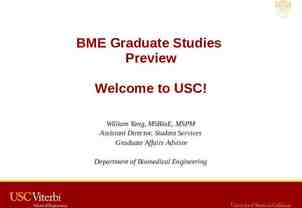WILDLIFE CROSSINGS Presented by: Cassondra Cruikshank Environmental
15 Slides6.41 MB
WILDLIFE CROSSINGS Presented by: Cassondra Cruikshank Environmental Biologist II Created by: Andrew M. Kevin M. Connor, MS Logsdon Senior Environmental Manager & Ecology & Permitting Branch H.W. Lochner, Inc. Manager KYTC The Robert L. B. Tobin Land Bridge in
WILDLIFE CROSSINGS In the United States alone, there are more than a million automobile accidents per year involving wildlife, racking up more than 8 billion in medical costs and vehicle repairs annually. According to some estimates, automobile collisions kill more ABSTRACT DESIGN RESEARCH than a million animals every day, making them the leading cause of death for many vertebrate species. In addition to injury and mortality major roads can subdivide animal populations and further fragment their habitats, making it more difficult to forage for food, find mates and carry on their genetic legacy and avoid inbreeding. Bridges and tunnels specifically designed for animals and their movements can reduce the environmental impact of
WILDLIFE CROSSINGS Wildlife crossings can come in many forms, depending on the species involved and the geographic features of the land. The most common forms of wildlife crossing are bridges and overpasses, tunnels, viaducts and culverts. When successfully implemented, wildlife crossings can greatly reduce the likelihood of collisions, provide a ABSTRACT RESEARCH safe corridor for animal transit and help reduce the ecological impact of highways by reconnecting animal habitats. The concept was first developed in France in the 1950s. It later took off in the Netherlands, where more than 600 crossings have been constructed to protect badgers, elk and other mammals. The Dutch have constructed an overpass for wildlife that spans more than 0.5 miles! DESIGN
RESEARCH ABSTRACT DESIGN Natuurbrug Zanderij Crailoo in the Netherlands
WILDLIFE CROSSINGS In Banff National Park in Alberta, Canada. Between 1996 and 2016, 44 structures — six bridges and 38 underpasses — were built for wildlife to traverse the Trans-Canada Highway, the nation's longest road, which bisects the park. Since its construction park officials documented more ABSTRACT DESIGN RESEARCH than 150,000 crossings by mammals such as elk, moose, black bears, cougar, and grizzly bears. Recent studies demonstrated that the corridors have specifically helped the grizzly bears maintain a wide enough selection of mates to stabilize their genetic flow. In addition, the mitigation contributed to an 80% reduction in motor accidents involving wildlife!
SO WHERE IS KENTUCKY? Answer: We’re working on it!
NEW FUNDS AVAILABLE TO STATE DOTS!! A grant funding opportunity to study and construct wildlife crossings through the FHWA’s Wildlife Crossing Pilot Program (WCPP) went live in April of this year. Applications by August 1! ABSTRACT RESEARCHwere due to FHWA Kentucky Transportation Cabinet, with the help of consultants, worked quickly to get a proposal together to receive some funds through the first round of selections later this year. Essentially started from scratch but in 3 months built quite an impressive team of stakeholders. DESIGN
KENTUCKY’s WCPP GRANT PROPOSAL AWARDED!
WHAT WILL WE STUDY Applying for non-construction funds initially to start the research and data collection phase. KYTC intends to coordinate with multiple agencies and environmental experts to develop a process and identify strategies that will provide substantial safety ABSTRACT RESEARCH benefits and advance safe, efficient transportation, in an environmentally sustainable manner. If funded KYTC will implement a planning process that has two compatible and beneficial scopes—a Statewide plan and a focused pilot corridor study to identify potential solutions that could be implemented throughout the state. DESIGN
WHAT WILL WE STUDY According to the State Farm Insurance Company’s 2022 report on animal collisions, the likelihood of an animal involved claim in Kentucky is 1 in 85. Kentucky ranks 19th in the nation for reported animal collisions. KYTC will start with a comprehensive assessment of the existing road network and its impact on wildlife populations will be conducted. This evaluation will identify key areas where road DESIGN ABSTRACT RESEARCH expansions and high traffic volumes intersect with important wildlife habitats and migration routes. The focused corridor study area includes segments of I-64 and US 60 between Frankfort, Kentucky (the State Capital) and the Jefferson County/Louisville Metro area (the most populous area in the state) and runs through parts of Jefferson, Shelby, and Franklin Counties.
WHY THAT SPECIFIC CORRIDOR? 11
WHY THAT SPECIFIC CORRIDOR?
WHO WILL WE WORK WITH? KYTC will have a “strategic partnership” with the Kentucky Department of Fish and Wildlife Resources (KDFWR) during the implementation of the grant and planning process. Some more supporting agencies and non-governmental groups include US Fish and Wildlife Service-KY Field Office, Kentucky Conservation Committee (Bluegrass Conservancy, Kentucky Natural Lands Trust, American Farmland Trust, and The Nature Conservancy of Kentucky), The Kentucky Sportsman Caucus. DESIGN ABSTRACT RESEARCH Our Commonwealth neighbor, Virginia, is about 5-7 years ahead of us in this process has reached out and is willing to assist in Kentucky’s effort. They have completed a successful WVC planning effort and are moving into the planning and construction phase soon. The hope is to one day team up on a crossing project along our border near Pine Mountain and US 460. Sixty seven elected officials throughout the state have prepared letters of support from their offices to FHWA in an effort to help KYTC be awarded funding.
PLEASE STAY TUNED 15







